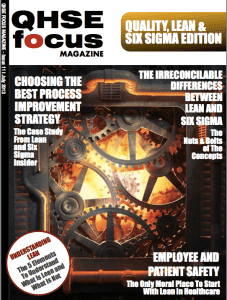 QHSE Focus, an iPad magazine, asked me to contribute a piece on Lean healthcare.
QHSE Focus, an iPad magazine, asked me to contribute a piece on Lean healthcare.
They published my piece titled, “Employee & Patient Safety: The Only Moral Place to Start with Lean in Healthcare.”
You can read a PDF of the article, thanks to the publishers at QHSE Focus. The PDF also contains the table of contents to the publication, which includes an excellent piece by Michael Balle on the “irreconcilable differences between Lean and Six Sigma”). You can get a free issue of QHSE via the iTunes store (further issues by paid subscription).
Excerpts from my article:
What should we hope to accomplish with the Lean methodology in healthcare organizations around the world? Taiichi Ohno, one of the creators of the Toyota Production System, wrote simply, “Start from need.”
…
Far too many patients are harmed or killed due to preventable errors and hospital acquired infections. Again, this is a worldwide problem. There is a moral imperative to use Lean and other process improvement methodologies to reduce errors and harm. Better processes and systems, not asking employees to be more careful in their chaotic settings, are the key to improving patient safety.
…
Lean, of course, is not just about setting targets. It's certainly not Lean to bribe employees with bonuses for having fewer injuries (as people might just stop reporting them) and it's especially not Lean to threaten people with punishment for not meeting safety goals.
…
To improve employee safety, we all have to work together to improve the process.
Michael Balle on Lean and Six Sigma
Some highlights from the Balle article:
Lean and six sigma are profoundly irreconcilable because they stem from different values, and seek different ideals – no matter how similar some of the specific tools might look like.
Why is this?
The fact that both DMAIC and kaizen have the same roots in Deming's PDCA should not obscure their profoundly different aims and underlying values. DMAIC is about having a specialist fix a process problem and then get employees to apply the patch to get the business result. Kaizen is about fostering teamwork by taking on challenging improvement topics and solving the “buds of problems” to learn how to better manage processes day to day. Lean's specificity can be expressed as: 1) techniques to visualize OK versus not-OK in day-to-day operations, 2) in order to develop the entire organization's problem solving abilities, so that 3) process capability improves, as well as process innovation.
No matter how hard people try to create the “lean six sigma” blend, these two trains don't run on parallel tracks, and there isn't space for common ground. Actually, lean six sigma is six sigma with some elements of lean included, such as “waste elimination”, and faster project turnaround, but it remains clearly in the six sigma field of process fixing to obtain immediate business results.
He adds:
Six sigma's aim is to fix the process through greater compliance and lean's aim is to foster the kaizen spirit so people manage better their processes. These are two very different goals, and unfortunately hard to reconcile…
Balle says that Six Sigma is “relatively easy to implement” because it “fits well with the traditional Taylorist structure and attitude” of most managers, while Lean requires “the CEO's full commitment …”
I agree with his observation that “Lean Six Sigma” most often seems to be a heavy Six Sigma approach with a few Lean tools thrown in (as I've written about before: “Just Call It ‘5S Six Sigma' Then.”
Your thoughts?
What do you think? Please scroll down (or click) to post a comment. Or please share the post with your thoughts on LinkedIn – and follow me or connect with me there.
Did you like this post? Make sure you don't miss a post or podcast — Subscribe to get notified about posts via email daily or weekly.
Check out my latest book, The Mistakes That Make Us: Cultivating a Culture of Learning and Innovation:










Comment from Ben Christiansen on LinkedIn:
Mark, thanks for sharing the excerpt from Ballé’s piece. I’ve long been vaguely uncomfortable with the “lean six sigma” terminology – what exactly did it mean, anyway? I think Ballé (and you previously) hit it right on the head – it’s really just a way to take Six Sigma and spruce it up around the edges. That makes a decent tool, but without the long-term organization-changing power of real, grassroots-driven continuous improvement.
If your approach to Six Sigma only involves a few specialists coming in to “save the day”, then you are doing Six Sigma wrong. Yes, the “Belt” hierarchy in Six Sigma makes it easy to think it is only about a few specialists but this is missing the fundamental point of the methodology. Six Sigma is about using data to truly understand a situation so that you can intervene with solutions targeted at proven root causes and then develop sustainable solutions. A key element to getting that deep understanding and ensuring long-term solutions stick is to work with employees throughout the process. A true deployment of Six Sigma in an organization, like a true deployment of Lean in an organization, requires that all staff members receive some training in the methodology and are empowered to use those tools to make a difference and to participate in improvement. If you don’t do that then you are doing it wrong whether it is Lean or Six Sigma.